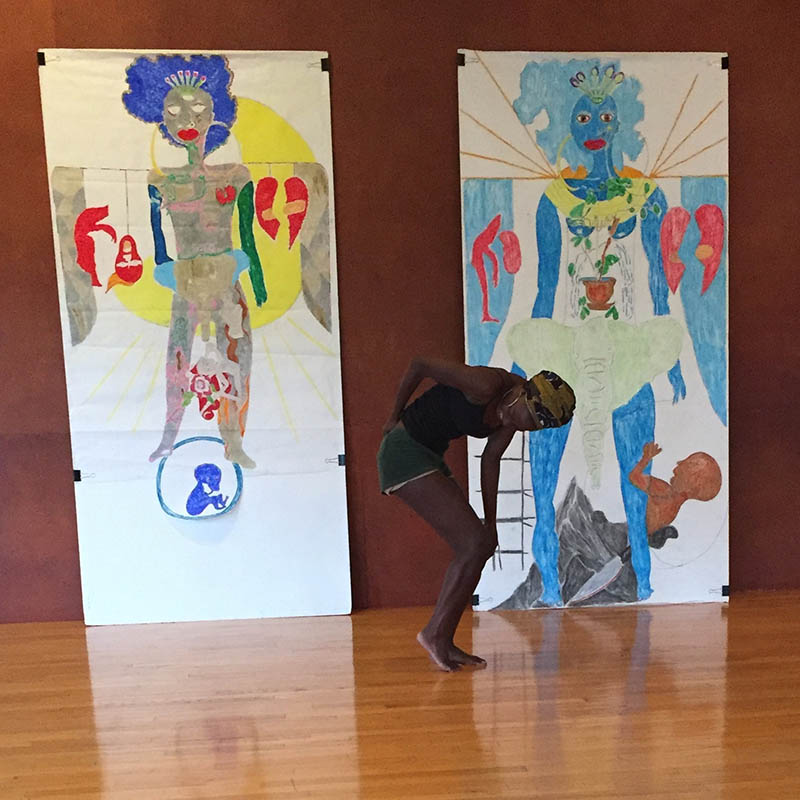LEVEL 1
PERSONAL EMBODIMENT OF THE LIFE/ART PROCESS®
Each part of the body – and every art medium – acts as a mirror that reflects aspects of ourselves, our relationship to others, and our relationship to the world. In Level 1, we use artistic and therapeutic principles to uncover and explore autobiographical material through a “body mythology” that connects us to the compelling events, issues, and questions in our lives. Working with intermodal art mediums – movement/dance, drawing, vocalizing, writing, and dialogues – we reflect on our history, who we are now, and the changes that we would like to embody in order to live more artfully in all aspects of our lives.
The training cohort also acts as a mirror. Through group creativity and learning, we develop the skills and sensitivity that allow the collective environment to serve as a place where transformation happens. The process that unfolds reflects the nature of interpersonal relationships, family stories, and community issues. It also motivates us to cultivate collaboration, collective creativity, skillful communication, and the value of differences and diversity within a supportive setting.
The training opens with introductions to the practice and the group. Following sessions focus on a different body part that inspires individual and group themes, art explorations, body awareness exercises, movement studies, partner and group interactions, and life/art metaphors that generate reflective questions.
Maps & Methods students will experience over the course of the training:
Body Part Mapping: Includes a study of the movement repertoire, associated themes and particular images and life experiences associated with each body part. The body parts which will be explored by students in the Level 1 training are listed below along with some of their associated themes:
- Head – Masking and Unmasking
- Throat – Voicing
- Spine – Posture in Life
- Shoulders – Burdens We Carry
- Arms & Hands – Reaching, Holding
- Ribcage – Opening, Closing
- Abdomen – Digesting, Eliminating, Assimilating, Gut Feelings
- Pelvis – Creation, Sexuality
- Legs & Feet – Balance /Off Balance, Grounding
Integrative Movement/Dance: Level 1 students will engage in unique activities and exercises which have been developed and taught at Tamalpa Institute over 40 years. These activities and exercises are representative of our movement-based approach to expressive arts education and therapy. For example, movement awareness and dance expression draws upon the specific movement repertoire of each body part and Movement Ritual 1, 2, 3 developed by Anna Halprin.
The Psychokinetic Imagery Process: A map for using movement, drawing and narrative to generate body/mind awareness, creative expression, and learning through multimedia art making.
RSVP Cycles: A system used to design and present experiences, performances and to generate collective creativity.
During the final phases of the training, a self-portrait is created and explored. The exploration begins with an in-depth movement inquiry into the personal myth and symbolic motifs of each individual art piece. This is followed by individualized coaching and scoring for a self-portrait performance. Each student’s self-portrait performance is enacted as a ritual within the safe container created by the Level 1 cohort and faculty. In the online format of the training, these performances are shared with the cohort and faculty via Zoom. The training ends with a harvest of the learning experience. Acts of group completion and transition facilitate the shift from the training community to daily life at home.
Level 1 may be taken on its own for personal development. For those who are interested in incorporating the work into their professional practice, it is the first step in our 3 Level professional training program which leads to certification as a Tamalpa Practitioner.
Learn more about our professional training program>
Suggested reading:
- The Expressive Body in Life, Art & Therapy by Daria Halprin – describes Tamalpa’s unique approach to healing through movement and art, and outlines the maps and methods used in our training program.
- Making Dances That Matter by Anna Halprin – describes how dance can be a powerful tool for healing, learning and mobilizing change, and offers insight and advice on facilitating groups.

